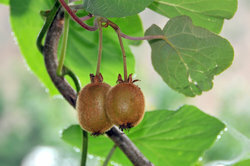Kiwi: a citrus fruit?
With its brown, furry skin, the kiwi is no beauty. But the exotic fruit, which is sometimes mistakenly called citrus fruit, has it all. Kiwis contain a lot of vitamin C and are therefore an indispensable part of our menu, especially in the winter months.

Citrus fruit, gooseberry or something completely different?
The real values are hidden inside - this also applies to the furry kiwi fruit, which started its triumphal march from China and New Zealand as a vitamin bomb.
- Kiwis belong to the genus of the ray pen, which bears the Latin name Actinidia. This vigorous climbing plant is native to East Asia.
- Only the fruits of a special variety, the Actinidia deliciosa, are edible. Because of its visual similarity to the gooseberry, this variety is also known as the Chinese gooseberry, but there is no biological relationship.
- Seeds of this Chinese gooseberry were discovered in the early 20th century. Exported from China to New Zealand in the 20th century. There the plant got its name "Kiwi" after the New Zealand national animal, the kiwi bird. Since the New Zealanders did not have the name protected by trademark law, it was soon used worldwide for the fruit.
- Today there are large kiwi plantations not only in New Zealand, but also in the central region (especially in Italy and Greece). From here, the fruit is also delivered to German supermarkets.
- Apart from their oval shape, the only thing the kiwi has in common with the citrus fruit is the high content of vitamin C. 100 grams of pulp contain around 70 mg of vitamin C as well as vitamin A, vitamin B, calcium, magnesium, iron and other minerals. If you compare this with the citrus fruit, which only contains around 50 mg of vitamin C per 100 g of pulp, it becomes clear why kiwis are so healthy. Fruit should be on the menu frequently, especially in winter when you have a cold.
- Please note, however, that some people are allergic to kiwifruit. This applies both to the consumption of the pulp and to bare skin contact with the furry fruit.
Hairy but healthy - eat kiwi with peel
Some types of fruit just have to be peeled - bananas or oranges, for example. Kiwi ...
Delicious and healthy - the kiwi in the kitchen
You can now buy kiwifruit in every supermarket. Whether you choose the Hayward variety or the Kiwi Gold with its yellowish flesh, this one is healthy fruit definitely and can be prepared in many different ways.
- When buying, look for ripe fruit. They give way slightly to pressure and are ready to eat right away. However, they can also be kept for a few days in the refrigerator.
- The easiest way to enjoy kiwi fruit is to cut it across and scoop out the flesh. The kiwi scoring spoons, which are available in stores, are very practical for on the go. At the end of the style you have a small point with which you can scratch the fruit and then divide it. You can use the spoon to spoon out the fruit right away - it's not just children who have fun with this ingenious device.
- Alternatively, you can peel the kiwi and cut it into a fruit salad, for example. The green pulp goes well with other colored fruits such as bananas, apples, oranges or strawberries.
- You can conjure up delicious jams from kiwis. Since the fruits lose their color quickly when cooked and then look unsightly, it is best to combine them with other fruits such as strawberries or rhubarb.
- With sugar, lemon juice, balsamicvinegar and spices such as chilli and curry, you can conjure up a delicious sweet and sour chutney from kiwis, which goes well with fried foods meat fits. Try it out at your next barbecue evening. The chutney will keep for several weeks in a cool place in the mason jar.
- Care must be taken when using kiwifruit with dairy products. Like pineapples, the raw fruits contain an enzyme that breaks down the milk protein and makes the food bitter. That can be prevented by adding a little bit of the fruit water and sauté sugar briefly.
- You can use this protein-splitting effect if you use raw kiwi fruit dessert Serve after foods with a high protein content, such as a cheese fondue. The enzyme then makes digestion easier.
How helpful do you find this article?


